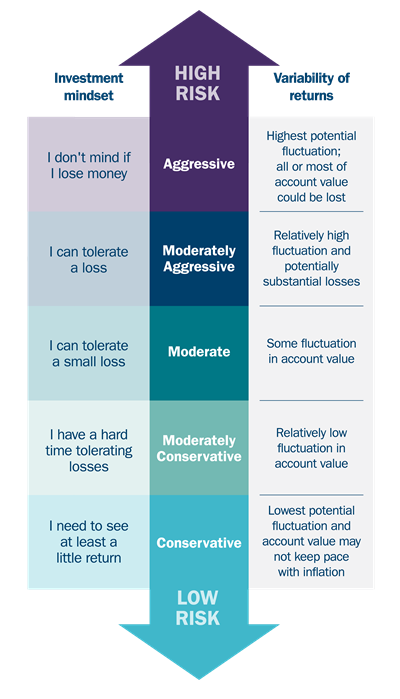The ability to accurately assess your risk tolerance is one of the foundational underpinnings of a well-designed investment portfolio.
Higher risk offers the potential for higher returns, but historically, chances are higher when you stay invested over time. If you lose your confidence during a down market and move to cash, you could miss an eventual recovery in stock prices. Determining your risk tolerance can help you avoid that mistake.
Typically, the process to help determine your risk tolerance in investing involves answering questions about your financial goals, investment objective and attitude toward market fluctuations. The purpose is to reveal where you are on the risk spectrum, ranging from conservative to aggressive. We factor that into the personalized investment recommendations provided to you.

The need for an honest risk tolerance assessment
Ancient Greek philosophers exhorted students to “know thyself.” Investors should do the same. With support from us, consider your hopes and fears, motivations and aspirations. Those factors might impact your attitude toward investment gains and losses, risks and rewards. This is a cornerstone principle of behavioral economics, which reminds us that we are human, not the rational actors that traditional economic models have assumed.
By assessing your risk tolerance level with us, you are less likely to abandon a thoughtful investment plan during a market selloff or take on excessive risk during a bull market. Unless you have a life-altering event or your financial goals change, you should anchor to a long-term portfolio. This requires only minor adjustments from time to time.
Personalized investment recommendations from us, your financial advisor
An Ameriprise Financial tool helps to make the process of determining your risk tolerance more interactive and intuitive. It uses a series of historical market scenarios to illustrate the impact of risk on your portfolio, in both percentage and dollar terms.
You will gain greater insight into how specific changes in risk tolerance and market behaviors are likely to impact your portfolio. In our view, this will lead to greater precision in defining what it means to be a conservative or aggressive investor, or somewhere in between.
To learn more about how to determine your investment risk tolerance and the role it plays in a sound portfolio, or if you have questions about your own profile, please speak with us.